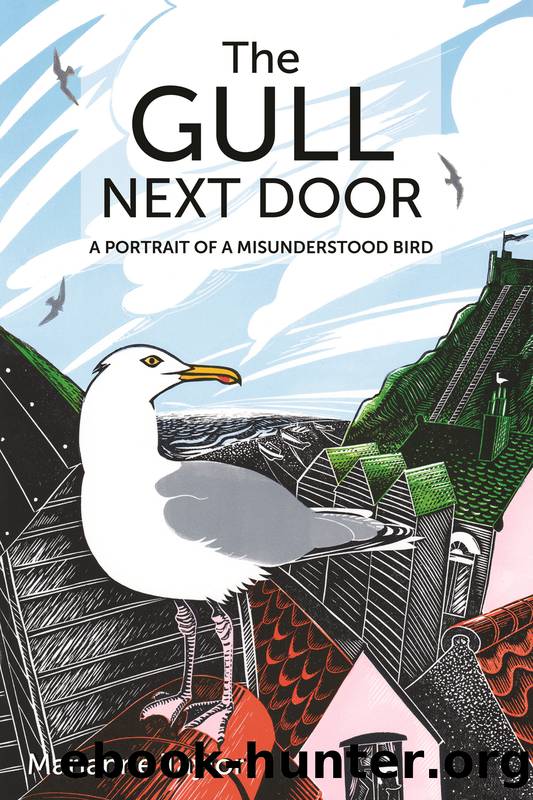The Gull Next Door: a Portrait of a Misunderstood Bird by Marianne Taylor

Author:Marianne Taylor
Language: eng
Format: epub
Publisher: Princeton University Press
Published: 2020-09-09T00:00:00+00:00
Herring gull
The commensalism goes back further than the invention of the black rubbish sack, though. As soon as we worked out how to catch fish, the gulls wanted to join our team. On one of my coastal walks in south-west Cornwall, I paused on the scarily narrow cliffside track to look out at the immensity of the Atlantic, and saw a small fishing boat creeping along way out over the sparkly ultramarine water. In its wake it trailed a heavenly escort of gulls, wheeling around the stern with the light behind their wings. That boatâs catch, hauled up from depths where it was out of reach to the gulls, drew the birds way out to sea, and then back again in to land to feast on scraps and leftovers. Back in the rough-hewn environs of Newlyn Harbour, the gulls look less heavenly and more mercenary, but theyâre there for the same reason â the chance of a free bite of fish. They loiter near the boats, and when the boats leave harbour, at least some of the hungry gulls will go with them. Gulls follow fishing boats, and it seems likely they have been doing this ever since people first made boats and nets, and took them out to sea.
Fishermen and fish-eating animals donât always get along famously. In the UK, people who own inland fisheries and angling ponds can legally kill cormorants and goosanders if they can demonstrate that these piscivorous birds threaten their livelihoods, and non-lethal control methods such as scaring have been tried and have failed. The level of vitriol some anglers have for cormorants in particular has to be seen (or read about on Facebook) to be believed. Some of these same wildlife-disliking freshwater anglers have also bemoaned the comeback of the otter in British waterways and called for a cull, spreading untruths about covert mass releases of captive-bred otters to try to stir up public feeling against them. This, unsurprisingly, isnât working â there can be few native British species more beloved than the otter. The anti-wildlife anglers seem not to mind kingfishers (yet) but certainly a minority of them look at grey herons somewhat askance, though plenty of other anglers love the waterline environment in all its diversity, and welcome all of the wildlife that shares their interests.
Thatâs fishing for fun. By and large, sea fishing is a different kettle of ⦠fish. Going out to sea to fish is mainly a commercial enterprise, and seabirds, traditionally, are quite popular with sea fishermen â watching for feeding seabirds can lead the way to a good spot to drop the nets, after all. Birds may follow boats, but boats might also follow birds. The most helpful seabirds in this respect are probably gannets, as they wander well offshore, and rather than being mainly scavengers and surface-pickers, will dive down and grab their own fish. It works both ways, too â a gannet knows that a fishing boat goes to where there are fish. A high-flying gannet can spot a boat from 11km away and will often approach to see what the boat has found.
Download
This site does not store any files on its server. We only index and link to content provided by other sites. Please contact the content providers to delete copyright contents if any and email us, we'll remove relevant links or contents immediately.
| Antarctica | Arctic |
Welcome to the Goddamn Ice Cube by Blair Braverman(1622)
Iced In by Chris Turney(1599)
Arctic Dreams by Barry Lopez(1436)
The White Darkness by David Grann(1357)
Mawson's Will by Lennard Bickel(1160)
Big Dead Place: Inside the Strange and Menacing World of Antarctica (Large Print 16pt) by Nicholas Johnson(1124)
Caroline Alexander by The Endurance: Shackleton's Legendary Antarctic Expedition(1108)
The Stowaway by Laurie Gwen Shapiro(1041)
South Pole by Elizabeth Leane(989)
Mummies and Pyramids by Mary Pope Osborne(988)
Tip of the Iceberg by Mark Adams(988)
In the Kingdom of Ice by Hampton Sides(980)
Bound by Ice by Sandra Neil Wallace(974)
Ice! by Tristan Jones(971)
Home by Beth Powning(935)
The Ice Balloon: S. A. Andree and the Heroic Age of Arctic Exploration by Wilkinson Alec(907)
Ice Diaries by Jean McNeil(873)
The Snow Walker by Farley Mowat(845)
Future Arctic by Edward Struzik(827)
